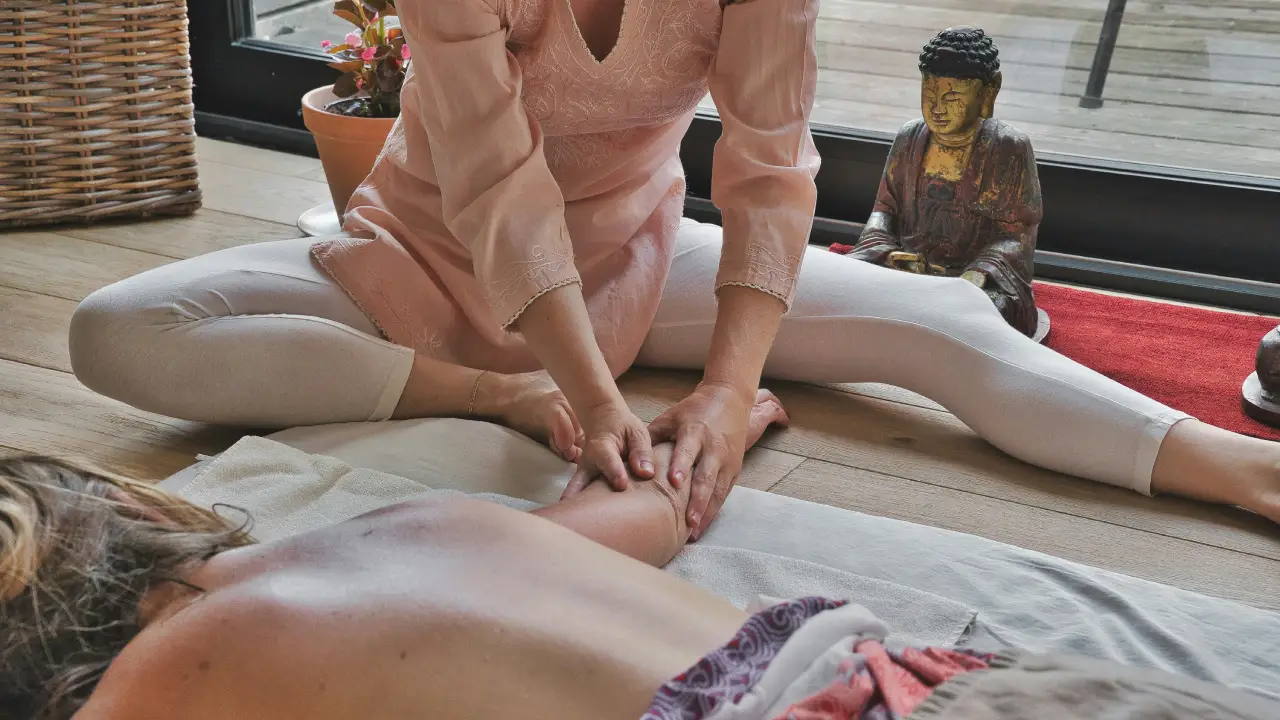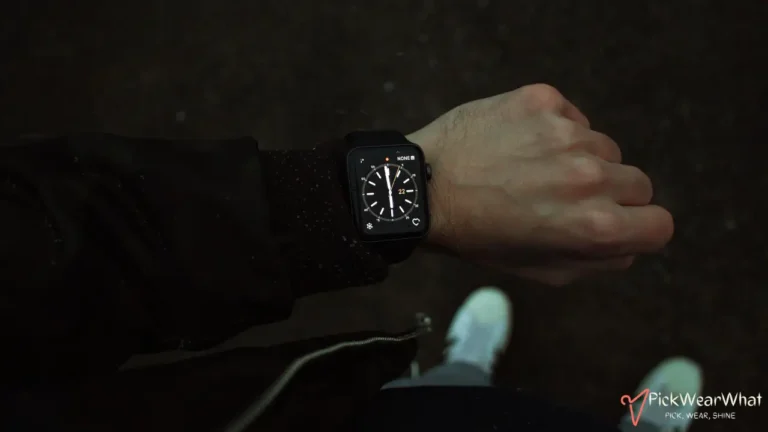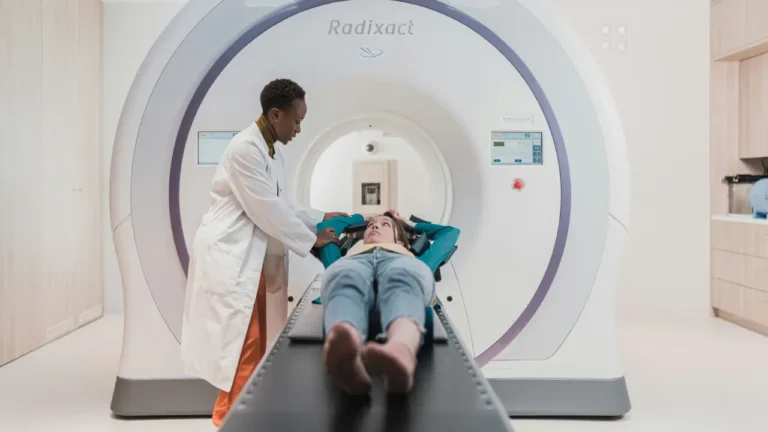You should wear loose, comfortable clothing to physical therapy. The goal is to allow full range of motion and comfort during exercises and stretches. Opt for athletic wear, such as t-shirts, shorts, or leggings, and supportive shoes like sneakers. Avoid tight or restrictive clothing, as it may limit movement and make exercises difficult during your therapy session.
What to Wear to Physical Therapy for Different Conditions?
You should wear comfortable and supportive clothing to physical therapy that allows freedom of movement specific to your condition. Depending on the type of injury or rehabilitation you are undergoing, the right clothing can make your therapy sessions more effective and enjoyable. Below are recommendations for what to wear to physical therapy based on different conditions.
What to Wear to Physical Therapy for Back Pain?
For physical therapy sessions focused on back pain relief, you should wear loose-fitting, flexible clothing that doesn’t put pressure on your back. Choose moisture-wicking t-shirts and athletic shorts or leggings, as these allow your therapist to guide you through stretches and exercises comfortably. Avoid tight waistbands or belts, as they can irritate your back. Supportive shoes, such as sneakers with good arch support, are essential to maintain posture and balance during exercises.
What to Wear to Physical Therapy for Knee Rehabilitation?
When attending physical therapy for knee rehabilitation, you should wear clothing that allows your therapist easy access to your knee area. Athletic shorts or loose-fitting pants are ideal since they won’t interfere with any braces or support devices you may need to wear. Choose breathable, flexible fabrics that won’t restrict your movement during knee exercises. Footwear should be supportive and stable to assist in walking exercises and to provide cushioning for your knees.
What to Wear to Physical Therapy for Hip Exercises?
During physical therapy sessions targeting the hips, wear clothing that permits full range of motion in your lower body. You should opt for stretchy, lightweight fabrics such as athletic leggings or track pants that allow your hips to move freely during exercises like stretches and lunges. Compression shorts under looser outer clothing can also offer extra support for the hip area. Supportive sneakers are crucial to protect your lower joints and promote stability during movement.
What to Wear to Physical Therapy for Leg Strengthening?
For leg strengthening exercises, you should wear clothing that ensures ease of movement and is not restrictive around the thighs and calves. Shorts, leggings, or flexible workout pants are ideal for performing squats, lunges, or resistance band exercises. Footwear should provide ample support, with cushioned soles and good traction to prevent slipping during leg exercises. Compression socks can also aid circulation and provide support during lower-leg rehabilitation.
What to Wear to Physical Therapy for Shoulder Recovery?
For physical therapy sessions focused on shoulder recovery, you should wear sleeveless tops or loose t-shirts that allow for easy access to the shoulder area. It’s important to choose clothing that permits free arm and shoulder movement, especially if you’ll be doing range-of-motion exercises. Avoid tight or restrictive sleeves, as they can hinder your ability to perform stretches. A well-fitting sports bra is also important for women to provide adequate support without restricting shoulder mobility.
What to Wear to Physical Therapy for Ankle Mobility?
When focusing on ankle mobility in physical therapy, you should wear clothing that allows access to your ankles, such as shorts, capri pants, or loose joggers. Your footwear should consist of supportive, well-cushioned sneakers with a good grip to prevent falls during balance exercises. You may need to remove your shoes for certain exercises, so wearing socks that provide stability on the floor, like non-slip grip socks, is advisable.
What to Wear to Physical Therapy for Sciatica Relief?
For sciatica relief, wear clothing that provides comfort and flexibility, as you will likely be doing stretches that engage your lower back, hips, and legs. Loose, stretchy yoga pants or athletic wear made from soft, breathable fabrics will help you move comfortably during therapy. Avoid clothing with tight waistbands, as this can aggravate your sciatica. As always, choose supportive sneakers to maintain stability and comfort during exercises.
Footwear Recommendations for Physical Therapy
You should wear supportive and comfortable footwear during physical therapy to ensure stability and prevent injury. The right shoes can enhance your ability to perform exercises effectively, provide necessary arch support, and reduce the risk of slips or falls. Below are some key recommendations for choosing the best footwear for physical therapy:
Supportive Sneakers
Opt for sneakers that offer good arch and heel support. These types of shoes help maintain balance and provide stability, especially during exercises involving standing, walking, or weight-bearing movements. Look for shoes with cushioned insoles to absorb impact and reduce strain on joints.
Cross-Trainers
Choose cross-training shoes for their versatility. They provide lateral stability, making them suitable for various physical therapy exercises, particularly those that involve side-to-side movements. Cross-trainers offer flexibility and support for a wide range of rehabilitation activities, from strength exercises to mobility work.
Slip-Resistant Soles
Shoes with slip-resistant soles are ideal for physical therapy as they prevent slips or falls on smooth surfaces. This feature is essential for exercises that focus on balance and mobility, ensuring safety during your therapy sessions.
Lightweight Running Shoes
Consider lightweight running shoes if your therapy involves a lot of walking, running drills, or leg strengthening exercises. These shoes offer flexibility and cushioning, promoting smoother movement and reducing pressure on your joints during high-impact activities.
Non-Slip Grip Socks
For exercises where you need to remove your shoes, non-slip grip socks provide the traction you need. They are perfect for maintaining stability during stretches or floor exercises while allowing your feet to move freely.
Avoid Sandals or Open-Toe Shoes
Avoid wearing sandals, flip-flops, or open-toe shoes to physical therapy, as they lack support and stability. Instead, opt for closed-toe shoes with secure lacing or Velcro to ensure your feet are protected and supported throughout your therapy sessions.
Tips for Dressing Comfortably During Physical Therapy
You should dress in comfortable and flexible clothing that allows a full range of motion when attending physical therapy. The right outfit can enhance your performance, reduce discomfort, and help you get the most out of your sessions. Here are some key tips for dressing comfortably during physical therapy:
Choose Breathable Fabrics
Opt for clothing made from breathable materials such as cotton, moisture-wicking fabric, or lightweight blends. These fabrics allow air to circulate and keep you cool, especially during exercises that cause you to sweat. Avoid thick, heavy materials that may trap heat and cause discomfort.
Wear Stretchable Clothing
You should wear clothes that are flexible and stretch with your body movements. Athletic wear like leggings, yoga pants, and loose-fitting t-shirts or tank tops are ideal because they accommodate a wide range of exercises without restricting movement.
Avoid Tight Waistbands or Belts
Tight waistbands or belts can hinder your range of motion and cause discomfort during exercises, especially for rehabilitation that targets your core, back, or hips. Choose pants or shorts with elastic waistbands to maintain flexibility and comfort throughout your session.
Layer for Temperature Control
Physical therapy sessions may take place in environments that vary in temperature. Layering your clothing allows you to adjust easily. You can start with a light jacket or hoodie and remove layers as your body warms up during exercises.
Opt for Supportive Undergarments
Supportive undergarments, such as sports bras for women and compression shorts, can improve comfort during therapy. These garments offer added support without restricting movement, ensuring that you stay focused on your exercises.
Avoid Excessive Accessories
It’s best to avoid wearing excessive accessories, like large jewelry or watches, that may interfere with movement or get in the way of your therapy exercises. Keep accessories minimal to maintain full focus and ease of movement during your session.
Prioritize Comfortable Footwear
As mentioned earlier, the right footwear is essential for comfort and support during physical therapy. Choose shoes with good arch support, cushioning, and stability to reduce strain on your joints and feet.
How to Ensure Mobility and Safety in Physical Therapy Clothing?
You should ensure that your clothing promotes mobility and safety during physical therapy by focusing on flexibility, fit, and function. Choosing the right clothing helps you move freely without restriction and protects you from potential hazards during exercises. Below are tips on how to ensure mobility and safety through your clothing choices for physical therapy:
Wear Flexible, Stretchy Fabrics
Choosing fabrics with stretch, such as spandex or polyester blends, ensures that your clothing moves with your body without restricting your range of motion. These fabrics provide ease of movement, making exercises like stretches, lunges, or squats more comfortable and effective.
Opt for Properly Fitted Clothing
Clothing that is too loose or too tight can pose safety risks. Loose clothing may get caught on equipment, while tight clothing can restrict movement or cause discomfort. You should wear properly fitted, athletic-style clothing that allows a full range of motion while staying secure and close to your body.
Avoid Clothing with Zippers or Buttons
Zippers, buttons, or other hard accessories can cause discomfort during exercises, especially if you’re lying down or using equipment. Opt for clothing with elastic waistbands or smooth finishes to prevent any pressure points or skin irritation during therapy.
Choose Slip-Resistant Footwear
You should prioritize safety by wearing footwear that has slip-resistant soles to prevent falls, particularly during balance and mobility exercises. Footwear should provide a stable base, ensuring that you maintain traction on various surfaces during your therapy session.
Select Clothing That Allows for Equipment Use
Ensure that your clothing is compatible with any equipment or therapy aids you may use during sessions. For example, if you need to wear a knee brace or ankle support, wear shorts or leggings that provide easy access to those areas. This will prevent the need for frequent adjustments, ensuring smoother therapy exercises.
Avoid Dangling Accessories
You should avoid wearing dangling jewelry, long necklaces, or loose accessories that could get caught on equipment or restrict movement during your exercises. Keeping accessories to a minimum improves safety and mobility during physical therapy.
Dress in Layers for Temperature Management
Temperature fluctuations in therapy environments can impact your comfort and mobility. Wearing layers allows you to adjust according to your body temperature. Start with a light outer layer that can be easily removed as your body warms up during exercises.
FAQs On What Do I Wear to Physical Therapy
You should wear comfortable, loose-fitting clothing that allows for full range of motion. Athletic wear such as t-shirts, leggings, shorts, and supportive sneakers are ideal. The key is to ensure your clothes do not restrict movement during exercises.
It’s best to avoid wearing jeans to physical therapy. Jeans can be restrictive, especially when doing exercises that involve stretching or flexibility. Opt for athletic pants, leggings, or shorts instead.
Yes, wearing supportive sneakers is recommended. Your shoes should provide good arch support and cushioning to help with balance, stability, and protection during therapy exercises. Avoid sandals, flip-flops, or open-toe shoes.
Yes, wearing a sports bra is advisable for women as it provides support and comfort during physical activities. Make sure the sports bra is well-fitted and allows freedom of movement.
It’s not always necessary to bring a change of clothes unless you expect to sweat heavily or go to work afterward. However, bringing a light jacket or hoodie can be helpful for adjusting to temperature changes during or after your session.




